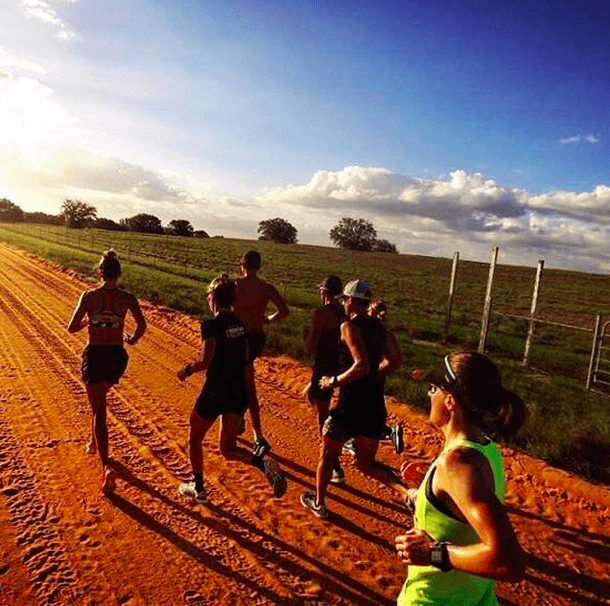Paul Duncan: A detailed guide to crushing your 5K


Photo: @christopherbagg – QT2 Systems Pro Camp
This part of the year is a great time to add in some short running races to try to assess early season fitness.
I often use a 5k test early season to help cross check and/or determine heart rate training zones, and training paces for athletes. A 5k is pretty close to an “all out effort”, so it’s very useful to help determine an athletes “red line” and “threshold” heart rate and pace. A 5k also makes for a gnarly speed workout! Just make sure that you approach it appropriately. Nothing more embarrassing than rolling out way too hard and slugging your way to a 5k finish.
Below is a quick guide for how you should approach your best possible 5k time.
Pre-Race Nutrition:
While what you eat before a 5k isn’t as crucial as it would be for a longer endurance event, it’s still important that you eat something that is going to be easily digestible and give you a quick boost of energy. There is no need to carb load for a race this short, but make sure the night before, you eat something that is quickly digested so it’s not lingering in your belly the next morning.
Before the race, I suggest keeping it very simple and light! Make sure your meal is low in fat and low in fiber to ensure digestion is fast. You can experiment with different foods in training. I suggest something along the lines of half an English muffin with some jelly, and maybe half a bottle of sports drink. Keep it around 200-300 calories. There are many ways to approach this, but the main priority, is keeping it light and easy to digest. I suggest eating about 2 hours before your race.
Make sure you are well hydrated for days before the event.
Warming up:
I always suggest showing up at least 60 minutes prior to the starting time. This will allow you to chill out a bit, hit the bathroom up once or twice, and get a nice little warm up in. Run around 15 to 20 minutes at a super easy pace just like you should before any quality run. In the last couple minutes of your warm up jog, include some “strides” at an effort faster than your predicted 5k pace. 3 to 4 sets of 30 seconds each is perfect. Do all this starting about 30-35 minute before the race.
Before the gun goes off, I suggest going some LIGHT dynamic stretching and just keeping the body moving.
Basic Overall Strategy:
Overall strategy is to run “conservatively strong” the first mile, and crushing the last mile. If you do a little research, you will see that every major record has been set running NEGATIVE SPLITS, meaning running the first half of the race slightly slower than the 2nd half. If you want run at your best possible outcome, running too fast out of the gate will destroy those chances. With race competition around you, paired with adrenaline, it can be very easy to start way too fast, but if you have been working with a good coach, you have been practicing pacing and negative splits for a while now!
Mile 1:
Start AT LEAST 5 seconds SLOWER than your goal pace (or your previous PR). If you are unsure of pace, I suggest using the QT2 Systems Run Calculator to help you determine a goal pace. Please remind yourself that this pace is going to feel SLOW if you have picked the right value. You are going to be running slower than the people you want to beat, it will require some mental strength to stay focused and patient, but just know you are being smart and you will pass them before the end of the race. Don’t even start to worry about your completion in the first mile, they mean nothing to you at this point, using them at this point will likely ruin the outcome of your race. Save your ego for the last mile.
Mile 2:
In the 2nd mile, it’s time to lock in your “goal pace”. It’s going to start feeling more difficult as you lock in that pace. Start looking around your competition. Find a group, or a person to latch on to, that is running at your goal pace. Focus on relaxing, and hanging with the group, and being right around goal pace. At 1.5 miles, it should start to hurt! This is 5k racing, so be ready for this to happen, and wrap your head around the idea that the pain is coming! Just hold the pace until the end of the mile.
Last 1.1 miles:
Now the actual “race” starts and you find out what your fitness is looking like. NOW is the time to start using your competition to your personal advantage. Look at the people in front of you, and start to reel them in, one by one. Chances are they are hurting worse than you are. Your goal is to dig deep and run as fast as you can at this point, use the people in front of you as bait. Remember, this mile is supposed to hurt, you are supposed to suffer here, the pain will subside as soon as you cross the finish line. Once you reach the last 400 meters, it’s everything you have left, all out.
If you were able to run the last mile slightly faster than the first, and it hurt like hell, you did a great job pacing. If you were fit and ready to race, you just set a new personal record.
About the author:
Paul is a United States Army Veteran, USAT Certified Coach, QT2 Systems Level 1 Coach, and OutRival Racing Level 3 coach.
Paul also competes in triathlon and running events in his spare time.
70.3 PR (4:24:26)
140.6 PR – (9:51:53)
Half Marathon – (1:24:21)
Marathon – (2:57:27)
Questions?
Contact Paul directly.
paul@qt2systems.com
Instagram: @paulduncanjr
